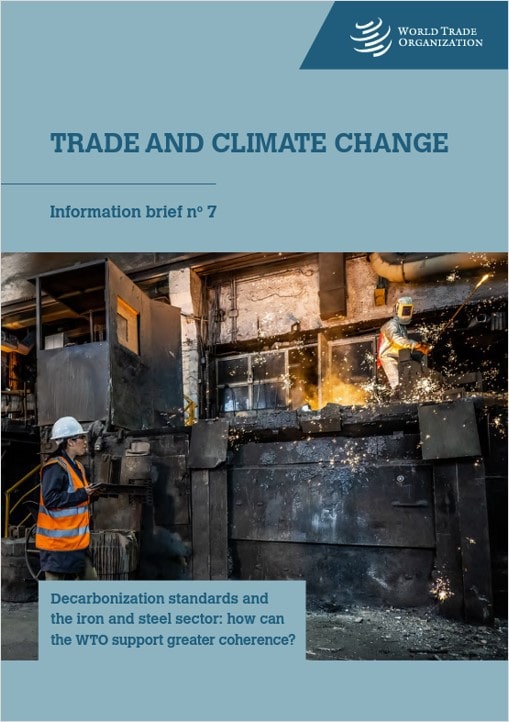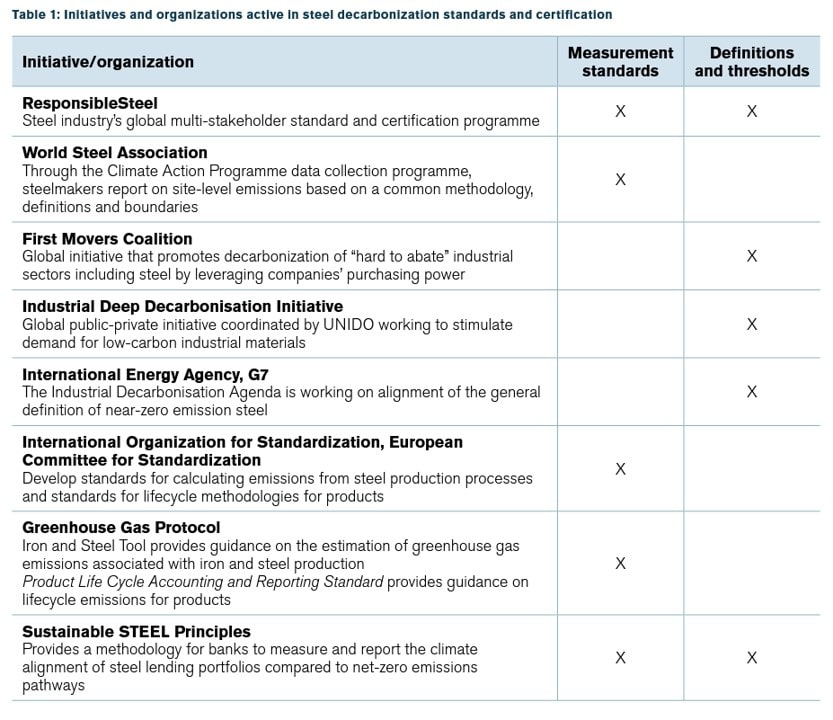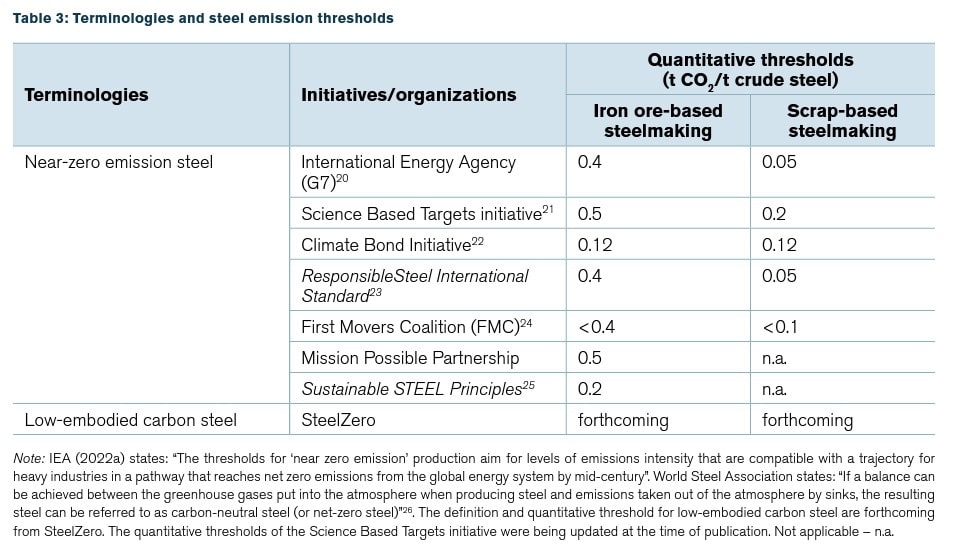How to use it
Trade and climate change: Decarbonizing steel
Published 20 June 2023
As efforts to address climate change accelerate, economies are focusing on decarbonizing the iron and steel sector. Differing approaches to decarbonization, including diverse standards and measurements of carbon emissions could lead to unpredictable, inefficient, and ineffective results. The World Trade Organization (WTO) in its new brief on trade and climate change offers analysis and ideas to promote coherent standards in this critical sector.
Here’s how to use the WTO Trade and Climate Change Brief.
Why is the WTO Trade and Climate Change Brief important?
Decarbonization standards in the iron and steel industries are proliferating. Navigating different standards can create costs and inefficiencies at a time when efforts must strive to be as effective and affordable as possible. This paper brings focus to the urgent need for greater coherence across economies and the importance of involving developing countries in decisions about the adoption of standards, while highlighting the role the WTO can play in bringing coherence to the standards.
What’s in the WTO Trade and Climate Change Brief?
The WTO Trade and Climate Change Brief includes the following three sections:
Introduction; Proliferation and the risk of fragmentation: challenges for trade and decarbonization
- Iron and steel production accounts for 8% of annual carbon emissions; global steel production has tripled in the past 50 years with 1.8 billion tons produced in 2020; 22.9% of steel products were traded in the same year; steelmaking emissions are difficult to reduce due to limited efficiency, abatement options, and costly alternatives. (pp. 4-5, Box 1)
- Consistent and transparent measurement, traceability, and verification underpin trade-related climate measures; good methodologies enable accurate information and comparisons across products, processes, and technologies and deliver confidence in net zero claims. (p. 4)
- Under stringent climate policies or pricing, first movers can suffer competitively; applying common standards can help by creating markets for green steel products. (pp. 4-5)
- There are 20 different steel decarbonization standards and initiatives, some with different boundaries and technologies; including mining, minerals, and metals industries, there are over 150 sustainability standards and initiatives; there are no globally accepted definitions of green, near-zero, or low-emission steel, or common global approach and methodology for assessing the lifecycle of embodied emissions. (pp. 5-6, Table 1)
- Standards for measuring emissions are needed to increase process efficiency, track the implementation of innovative technologies, and provide emissions data to consumers, for regulatory compliance and to access green financing. (pp. 7 and 9)
- The International Energy Agency (IEA) identifies four key features for emissions measurement standards, i) emission scope and targeted greenhouse gases; ii) supply chain scope; iii) granularity of application; and iv) measurement methodologies and data requirements; different standards calculate each feature in different ways. (pp. 7-9; Table 2)
- Definitions and performance thresholds for low-carbon or near-zero steel are important for stimulating investment in low-carbon markets and enabling price differentiation to help mitigate carbon leakage, provide a basis for government policy to support low-carbon technologies and green government procurement, and inform consumers. (p. 10)
- To be effective and credible, definitions and thresholds should be based on agreed, consistent, comparable, and transparent measurement standards, taking into account scrap steel usage given its contribution to lower carbon footprints compared to iron-ore-based production. (p. 10)
- Near-zero steel and net-zero steel represent the highest decarbonization ambitions; such definitions are being refined and developed continually including associated quantitative thresholds of allowable tons of CO2 emissions per ton of crude steel. (pp. 10-11, Table 3)
- Some initiatives develop performance standards based on technology maturity models with progressive bands or levels, and set out targets toward near-zero steelmaking; performance scales vary depending on criteria. (p. 11-12, Tables 4-6)
- Discrepancies between standards create difficulties for comparability, transparency, measurement, reporting, and verification; a well-understood basis for measurement is needed for trust and cooperation in trade; standards and definitions should take into account the impact on downstream industries, and carbon standards for competing materials like concrete. (p. 13)
- Considering existing discrepancies in standards and definitions, the range of standards across economies and companies, and the importance of measuring carbon emissions in this sector, there is scope for greater cohesion and international cooperation. (pp. 14-15)
Considerations for coherence and support for developing countries
- Coherent standards, definitions, and thresholds in the steel sector should be
- globally relevant and technology neutral, meaning standards that are performance rather than tech-based and ensure that all facilities globally can cut emissions; (p. 16)
- science-based and ambitious, to meet targets set in the Paris Climate Agreement and ensure that new investments meet emissions targets throughout their lifespans; (p. 17)
- measurable in terms of boundaries and scope, considering whether to start calculations from the point of raw materials extraction or later and to end calculations with crude or finished steel; whether a company has leverage over all stages of production; and the impact on emissions accounting for other activities or competing materials; (p. 17)
- transparent in monitoring, reporting, and verification, which plays a critical role in engendering trust among regulators and the market; and (pp. 17-18)
- incorporate needs and participation of developing countries, which is important as they may account for up to three-quarters of future growth in steel demand while lacking resources to measure and verify the carbon content of their products. (pp. 18-19)
- Given the nature of the industry, several different standards may need to co-exist while incorporating common understandings and building towards convergence. (p. 16)
- Data requirements and assumptions underlying some standards may give a distorted view of emissions in developing countries that do not have a long history of production; developing countries have limited representation in standards development; technical assistance and capacity building can help to address these challenges. (pp. 18-19)
Role of the WTO
- While the WTO doesn’t set standards, it does bring together 164 member governments to work cooperatively to enhance transparency in standards. (p. 19)
- The WTO can provide a robust global legal framework and guidance on the preparation, adoption, application, and harmonization of standards; offer transparency mechanisms and space to discuss and address trade concerns arising from the proliferation of different standards; and host specialized bodies and experts on trade, standards, and environment. (pp. 19-21)
- Convergence is important for predictability for producers, especially those engaged in trade, to avoid the cost and inefficiency of navigating different emissions requirements, which could diminish cross-border investment and lead to trade tensions. (p. 20)
How to apply the insights
-
This section highlights the WTO’s capabilities and resources for understanding, harmonizing, and developing best practices, including transparency, with respect to standards. This section should prompt policymakers to consider using the WTO and its resources to conduct the difficult work of developing common standards. This section could be useful to policymakers and other analysts to understand where to invest in data collection to facilitate required future analysis.
Conclusion
The WTO Trade and Climate Change Brief provides a helpful analysis of the current state of play in developing steel and iron industry decarbonization standards, the reasons why coherence in standards is vital, and the tools the WTO can provide to help create coherent standards.
Complementary reports and analysis
Hinrich Foundation
- Sneak peek: Chart art on carbon markets
- To Stop Carbon ‘Leakage,’ Can Border Tax Help?
- Counting carbon: The implications of border carbon adjustments on developing countries
External Resources
- Carbon border adjustments, climate clubs, and subsidiary races when climate policies vary – Peterson Institute of International Economics
Economies experience policy spillovers associated with diverse policy approaches to climate change. - The EU’s Carbon Border Tax is Likely to do More Harm than Good – Policy Center for the New South
Can a carbon border tax help prevent carbon leakage? - U.S. Proposes Green Steel Club That Would Levy Tariffs On Outliers – The New York Times
The US proposes a system to incentivize green steel production. - A Green Steel Deal: Toward Pro-Jobs, Pro-Climate Transatlantic Cooperation on Carbon Border Measures - Roosevelt Institute
Could a green steel initiative promote US employment and help climate change?
© The Hinrich Foundation. See our website Terms and conditions for our copyright and reprint policy. All statements of fact and the views, conclusions and recommendations expressed in this publication are the sole responsibility of the author(s).


